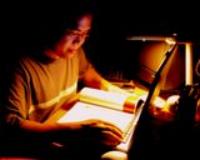
Man reviewing a book.
Book reviews appear in a variety of publications including academic journals, magazines, newspapers and on websites. However, surprisingly little has been written about how a book review should be written. These activities, aimed primarily at postgraduate research students focus on writing book reviews for academic journals, though the principles can be applied to writing other kinds of book reviews too.
• To understand what a book review is and is not
• To explore the characteristics of a good book review
• To be able to write a good book review for a journal or other publication
You have probably read book reviews in newspapers, magazines, online or possibly in academic journals. The 'book report' is a common form of activity in school, though probably more so in North America than in the UK. This first activity will help you to think about what a book review is.
In your opinion, what is the purpose of a book review? Make notes in the box below.
This activity has considered books reviews in general. The following activites are more specifically focused on book reviews for academic journals.
Many academic journals have book review sections. Subject associations sometimes put calls for book reviewers in their newsletters or e-mails lists along with a list of books that need reviewing for their journal. Even if the journals in your field do not do this, there is no harm in contacting the book review editor and asking him/her if you can review a book.
Look at the following list of reasons for writing a book review. Decide whether you think they are good reasons or bad reasons by selecting the appropriate button underneath each one.
1. To evaluate a book's contribution to your field of study
2. To get your name in print
3. To read a book which will contribute to your own research
4. To get a free book
5. To help others in your field decide whether or not they should read the book
It is likely that most readers of your review will not have read the book you are reviewing. Ultimately your task is to help the reader to decide whether or not to read the book.
Look at the following list. What questions should you ask and answer when writing a book review? Select the tick symbol next to those questions you think are good ones, and select the cross next to those which you think are bad reasons.


What contribution does the book make to your field of study?
What are the author's key arguments?
What are the strengths and weaknesses of the book?
What audience is the book aimed at?
What are the highlights of the book?
Is it worthwhile for others to read it?
Does the the book support or challenge existing scholarship in the field?
In this activity, you will examine Sarah Rule's 2009 review of John Field's book 'Listening in the Language Classroom,' an academic review which was published in Liaison, the magazine for the Subject Centre for Languages, Linguistics and Area Studies. You will read this review and then consider the characteristics of good reviews.
Open the link below and read the review. Use the review to decide what the characteristics of a good book review are and tick the boxes beside those aspects you feel are characteristic of good book reviews.
Sarah Rule: review of 'Listening in the Language Classroom' (2009)
A good academic book review...
 |
| John Field Cambridge University Press ISBN 978-0521-68570-2 |
| Dr Sarah Rule is a Lecturer in Linguistics at the University of Southampton. |
 |
| John Palfrey and Urs Gasser Basic Books ISBN: 978-0465005154 |
| Scott Windeatt is Head of the Applied Linguistics and TESOL section in the School of Education, Communication and Language Sciences at Newcastle University. |
© John Canning, University of Southampton, 20 August 2009. Image copyright http://www.flickr.com/photos/pixeleden/132146491/ Creative Commons
